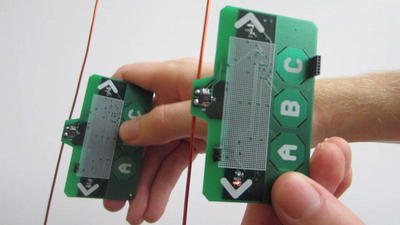Battery-free wireless devices

University of Washington (UW) engineers have created a new wireless communication system that allows devices to interact with each other without relying on batteries or wires for power. The devices exchange information by reflecting or absorbing pre-existing radio signals. The new communication technique, which the researchers call “ambient backscatter”, takes advantage of the TV and cellular transmissions that already surround us around the clock.
The researchers built small, battery-free devices with antennas that can detect, harness and reflect a TV signal, which then is picked up by other similar devices. The technology could enable a network of devices and sensors to communicate with no power source or human attention.

“We can repurpose wireless signals that are already around us into both a source of power and a communication medium,” said lead researcher Shyam Gollakota, a UW assistant professor of computer science and engineering.
“It’s hopefully going to have applications in a number of areas including wearable computing, smart homes and self-sustaining sensor networks.”
“You can reflect these signals slightly to create a Morse code of communication between battery-free devices,” said co-author Joshua Smith, a UW associate professor of computer science and engineering and of electrical engineering.
Everyday objects could be enabled with battery-free tags to communicate with each other. A couch could use ambient backscatter to let the user know where his keys were left. Smart sensors could be built and placed permanently inside nearly any structure, then set to communicate with each other.
The researchers tested the ambient backscatter technique with credit-card-sized prototype devices placed within several feet of each other. For each device the researchers built antennas into ordinary circuit boards that flash an LED light when receiving a communication signal from another device.
Researchers demonstrate how one payment card can transfer funds to another card by leveraging the existing wireless signals around them. Ambient RF signals are both the power source and the communication medium.
The applications are endless, the researchers say, and they plan to continue advancing the capacity and range of the ambient backscatter communication network. The other researchers involved are David Wetherall, a UW professor of computer science and engineering, Vincent Liu, a doctoral student in computer science and engineering, and Aaron Parks and Vamsi Talla, both doctoral students in electrical engineering.
The research was funded by the University of Washington through a Google Faculty Research Award and by the National Science Foundation’s Research Center for Sensorimotor Neural Engineering at the UW.
Soft robot uses magnetic fields to power itself autonomously
Inspired by the movement of manta rays, researchers have developed a small, magnetically powered...
Perovskite 'energy sandwich' could power next-gen solar
Researchers have achieved a new level of control over the atomic structure of halide perovskites,...
Creating the truck of tomorrow
Exploring the technological innovations, infrastructure solutions and emerging delivery methods...




